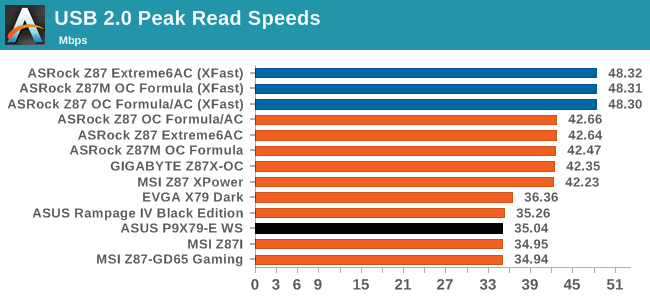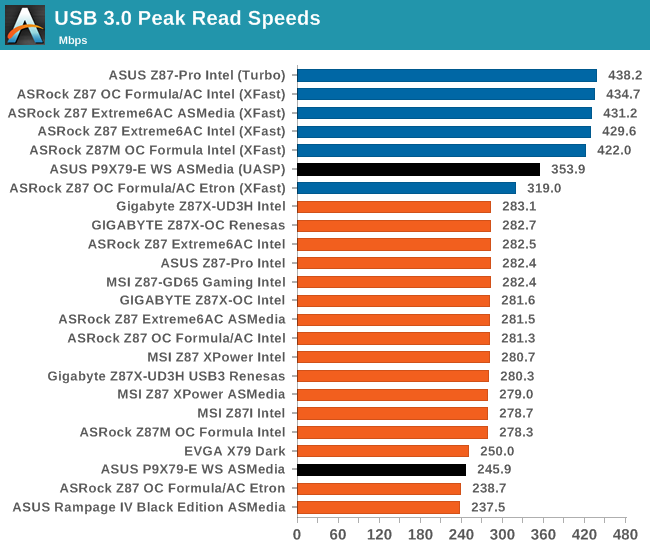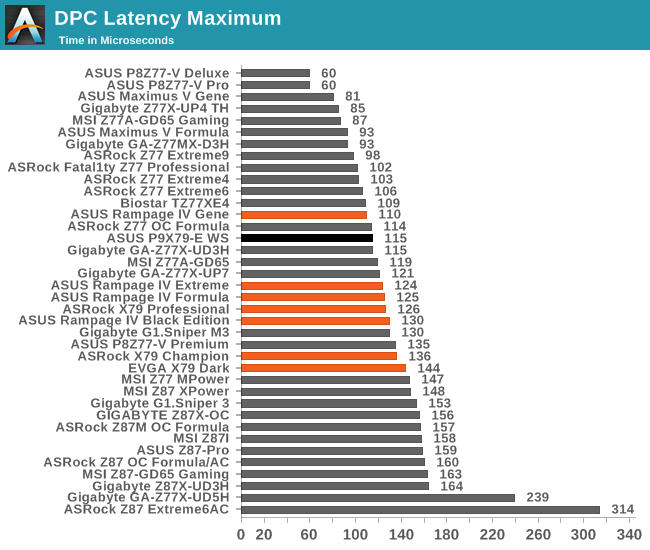ASUS P9X79-E WS Review: Xeon meets PLX for 7x
by Ian Cutress on January 10, 2014 10:00 AM EST- Posted in
- Motherboards
- Asus
- Workstation
- X79
- Prosumer
Rightmark Audio Analyzer 6.2.5
In part due to reader requests, we are pleased to include Rightmark Audio Analyzer results in our benchmark suite. The premise behind Rightmark:AA is to test the input and output of the audio system to determine noise levels, range, harmonic distortion, stereo crosstalk and so forth. Rightmark:AA should indicate how well the sound system is built and isolated from electrical interference (either internally or externally). For this test we connect the Line Out to the Line In using a short six inch 3.5mm to 3.5mm high-quality jack, turn the OS speaker volume to 100%, and run the Rightmark default test suite at 192 kHz, 24-bit. The OS is tuned to 192 kHz/24-bit input and output, and the Line-In volume is adjusted until we have the best RMAA value in the mini-pretest. We look specifically at the Dynamic Range of the audio codec used on board, as well as the Total Harmonic Distortion + Noise.


I expressed my surprise to see the Realtek ALC1150 used on the P9X79-E WS, and even without the extra treatment given to it on some other motherboards it performs better than expected here.
USB Backup
For this benchmark, we run CrystalDiskMark to determine the ideal sequential read and write speeds for the USB port using our 240 GB OCZ Vertex3 SSD with a SATA 6 Gbps to USB 3.0 converter. Then we transfer a set size of files from the SSD to the USB drive using DiskBench, which monitors the time taken to transfer. The files transferred are a 1.52 GB set of 2867 files across 320 folders – 95% of these files are small typical website files, and the rest (90% of the size) are the videos used in the WinRAR test. In an update to pre-Z87 testing, we also run MaxCPU to load up one of the threads during the test which improves general performance up to 15% by causing all the internal pathways to run at full speed.


The lack of native USB 3.0 really does hurt the older platforms especially when trying to bring them into new personas.
DPC Latency
Deferred Procedure Call latency is a way in which Windows handles interrupt servicing. In order to wait for a processor to acknowledge the request, the system will queue all interrupt requests by priority. Critical interrupts will be handled as soon as possible, whereas lesser priority requests, such as audio, will be further down the line. So if the audio device requires data, it will have to wait until the request is processed before the buffer is filled. If the device drivers of higher priority components in a system are poorly implemented, this can cause delays in request scheduling and process time, resulting in an empty audio buffer – this leads to characteristic audible pauses, pops and clicks. Having a bigger buffer and correctly implemented system drivers obviously helps in this regard. The DPC latency checker measures how much time is processing DPCs from driver invocation – the lower the value will result in better audio transfer at smaller buffer sizes. Results are measured in microseconds and taken as the peak latency while cycling through a series of short HD videos - under 500 microseconds usually gets the green light, but the lower the better.

In typical WS fashion, a low DPC Latency is required for DAW users, and at 115 microseconds (peak), the P9X79-E WS does a good job.










53 Comments
View All Comments
Hammerfist - Friday, January 10, 2014 - link
What are the effects of PLX chip when using two or more R9 290 in crossfire ?We know that when doing AFR , R9 290 and R9 290X uses the PCIe lanes to move the frame around from on GPU to another .
A frame time testing with two GPUs in different lanes will be very interesting .
PCIe 1 - PCIe 2 -> Goes through the PLX chip and QS
PCIe 2 - PCIe 3 -> Goes through QS only
PCIe 1 - PCIe 5 -> Goes through both PLX chips
PCIe 2 - PCIe 6 -> Goes through both PLX and QS chips
and possibly more combinations.
I am not saying that all possible combinations need to be tested , just two combinations to give us and idea of the latency involved is good enough like
1) PCIe1 - PCIe3 (only PLX)
2) PCIe2 - PCIe6 (both PLX and QS)
Ian Cutress - Saturday, January 11, 2014 - link
I did some PLX testing on various Z87 motherboards that use one of the chips, and the overall defecit over ideal routing was a 1-2% loss per PLX chip in the worst case scenario. This is better than the old NF200s, which had up to a 5-10% loss iirc? Of course with X79 it's a little different in that the CPU could go for an x16/x8/x8/x8 layout and whether going for an x16/x16/x16/x16 would make a difference. While I don't have 290 cards to hand, I do have 7970s and now GTX 770s to do a small comparison in the future.watersb - Saturday, January 11, 2014 - link
Ian, thanks very much for this review.I am not a gamer, but my science and storage workloads are well met by Xeon workstations. The build-your-own route can make financial sense sometimes, depends on the job.
Glad you are there checking it all out.
mapesdhs - Saturday, January 11, 2014 - link
The main benefit of a DIY oc build is gaining access to the performance equivalent to anexpensive high-core XEON on a lower budget. XEONs with lots of cores have much lower
clocks, so a 6-core SB-E or IB-E at 4.7+ runs very well. There are tradeoffs of course,
such as non-ECC RAM being used; this might rule out the idea for some tasks. Still, there's
a lot of scope for building something fast without breaking the bank. If one needs a degree
of reliability though then I guess just step back a step or two on the oc, say 4.5GHz, and/or
go for top-end cooling by default such as an H110 + suitable case.
Ian.
Pooyan - Saturday, January 11, 2014 - link
Great article, Ian. Although I wish you focused more on workstation aspects of the motherboard, not gamin and stuff :D1. Do you know any motherboards from other manufacturers with similar specs?
2. ASUS says it's a CEB motherboard. So the case has to be CEB as well? Or can it be E-ATX? Isn't that kinda small for it?
Thanks again for the review.
mapesdhs - Saturday, January 11, 2014 - link
The only other board I could find that came close in overall concept to ASUS' X79 WSseries is Asrock's X79 Extreme 11. However, apart from being quite a bit more expensive,
in the end I felt Asrock messed up a bit by not using a SAS controller with any onboard
cache, which can spoil 4K performance. Given the board cost, I can't imagine why the
didn't choose an equivalent LSI chip that had a 1GB cache or something, would have
been much better. Maybe the added cost was just too much.
Can't remember offhand about CEB vs. EATX; I think CEB means the board can be
deeper aswell as longer. Either way, fits fine in a HAF 932, though the case I'd
recommend atm is an Aercool X-Predator. Caveat: if one has to move a system
around a lot, eg. transport to company sites, then choose a different case that has
handles. Either way, for max expandability, use a 10-slot case.
Ian.
Pooyan - Tuesday, January 14, 2014 - link
I thought it only fits in a CEB case. That's why I was gonna get a Silverstone RV03, because that's the only CEB I could find. This is a great help for me. It means I have other options for the case. Thanks a lot!mapesdhs - Tuesday, June 7, 2016 - link
An old thread I know, but a minor update for anyone who finds this for some reason as I recently built an editing setup with a P9X79-E WS I managed to get for only 200 quid (fitted with an i7 3970X, Quadro 6000, GTX 580 3GB, etc.): now I'm using a Corsair C70 Military Green case, definitely better. More rear slots than the HAF 932, though I'm only using two NDS fans with the H110 (decided after several builds that four is unnecessary). The C70 has fewer front 5.25" bays than the 932, but using more SSDs, etc. has meant that's not an issue.Hoping to see if it's possible to boot from a 950 Pro soon...
Ian.
Umbongo - Saturday, January 11, 2014 - link
"Being a Workstation board, the P9X79-E WS is designed to accept any socket 2011 Xeon, as well as ECC memory – up to 64GB is listed on the specification sheet, although 16GB ECC DRAM modules are now available through Newegg for $210 each."The X79 chipset supports unbuffered ECC with a Xeon. 16GB DIMMs are not available as ECC unbuffered, only ECC registered. You need a C600 series chipset with a Xeon to use registered memory.
Ian Cutress - Saturday, January 11, 2014 - link
Ah, I thought I had seen 16GB unregistered memory. Seems like I was mistaken (!)